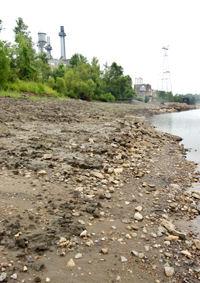Low Water, No Power:
Ameren energy plant reopens after closing because of low river
levels
BY KRISTEN CATES, THE SOUTHERN

The Ameren CIPS plant in Grand Tower,
left, has been forced to cease operations due to low river
conditions of the Mississippi River,right. (CEASAR MARAGNI/THE
SOUTHERN) |
SOUTHERN ILLINOIS -
Don Hawthorne doesn't have to be told Southern Illinois is
experiencing a moderate drought.
The De Soto farmer laughs at the label the region has been given
by the National Weather Service.
"I think it's worse than moderate," he said.
Hawthorne has 200 acres of soybeans he's trying to get through the
season, but said he might only yield 50 percent of that crop.
"A lot of the pods from about half-way up (the stalk) have no
beans," he said.
Mary Lamm, a
service hydrologist with the National Weather Service in Paducah
said Southern Illinois is considered to be in a moderate drought
because the lack of rainfall is great enough that it's having an
agricultural and hydrological impact on the area.
"It's just a rainfall deficit," she said.
Farmers aren't the only ones feeling the impact of this drought.
The Mississippi and Ohio rivers are running at critically low
stages. The Mississippi level is low enough that the Ameren Energy
Generation Co. plant in Grand Tower shut down for a couple of
weeks in July.
Ameren Corporation spokesperson Leigh Morris said water levels
were too low to generate enough electricity. But that is not the
case right now.
"As the present time there is adequate water," he said.
Customers' power supply has not been affected because electricity
is available from several other sources in the state.
"The plant is available to produce electricity if necessary," he
said.
According to Kai Roth, a hydrologist with the Lower Mississippi
River Forecasting Center in Louisiana, the river at Chester sits
at 3.3 feet, compared to 6.1 feet last year.
At Cape Girardeau, the Mississippi is sitting at a stage of 8.4
feet when last year it was 12.4 feet. Roth said a normal stage at
this point in the year near Cape Girardeau is 15 feet.
"We're reaching critical levels on both the Mississippi and Ohio,"
Roth said.
It's become critical enough on the Mississippi River that the Army
Corps of Engineers is bringing out the dredges right now to remove
excess sand along the river bottom so that the channels stay at 9
feet deep, as required for river traffic, according to
spokesperson Nicole Dalrymple.
"We haven't had any restrictions on the Mississippi as of yet,"
she said.
The U.S. Coast Guard is just advising mariners of low-level
channels and asking those with heavier loads to make adjustments.
Even though the past few days have produced some precipitation,
officials with the National Weather Service said there isn't too
much relief in sight. The summer months in this area average 3.94
inches of rainfall, according to Dave Purdy, a meteorological
technician with the National Weather Service.
Thus far, August has only produced 1.01 inches of rain, he said.
"Every place around here is like five to six inches behind for the
year," Purdy said.
The total rainfall for the region in 2004 amounted to 44.42
inches, just below the normal rainfall of 45.81 inches expected
annually for the region.
To date in 2005, only 22.66 inches of rain have fallen in Southern
Illinois, compared to the 29.17 inches that had fallen this time
last year.
But Purdy said the problem really started in the spring, with
monthly averages of 7 inches of rainfall. A normal spring season
sees 13 inches of rain fall each month.
Lamm said this is the worst the drought has been so far this year
and is probably the worst it will get, but still, the 30 to 90 day
forecasts don't look to improve the conditions.
"It's not going to get better any time soon," Lamm said. "There
would have to be widespread rainfall."
Hawthorne said this drought obviously hasn't been good for his
beans.
"It sure ain't helping it any," he said.
kristen.cates@thesouthern.com
618-529-5454 x5804
